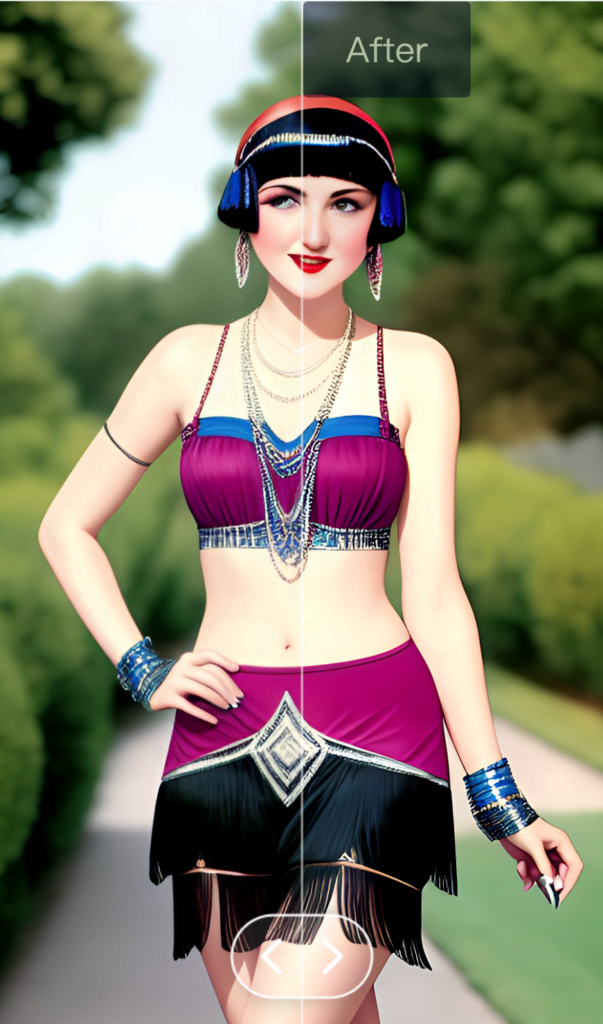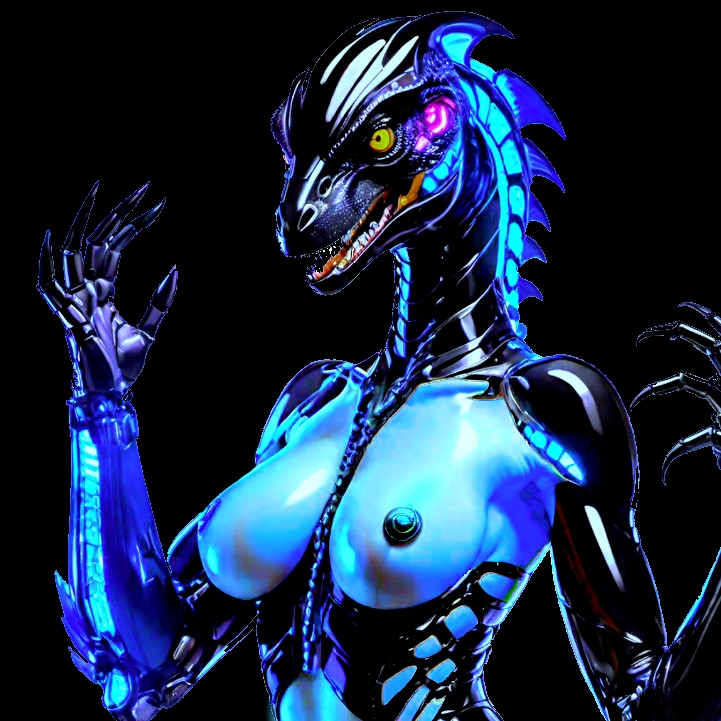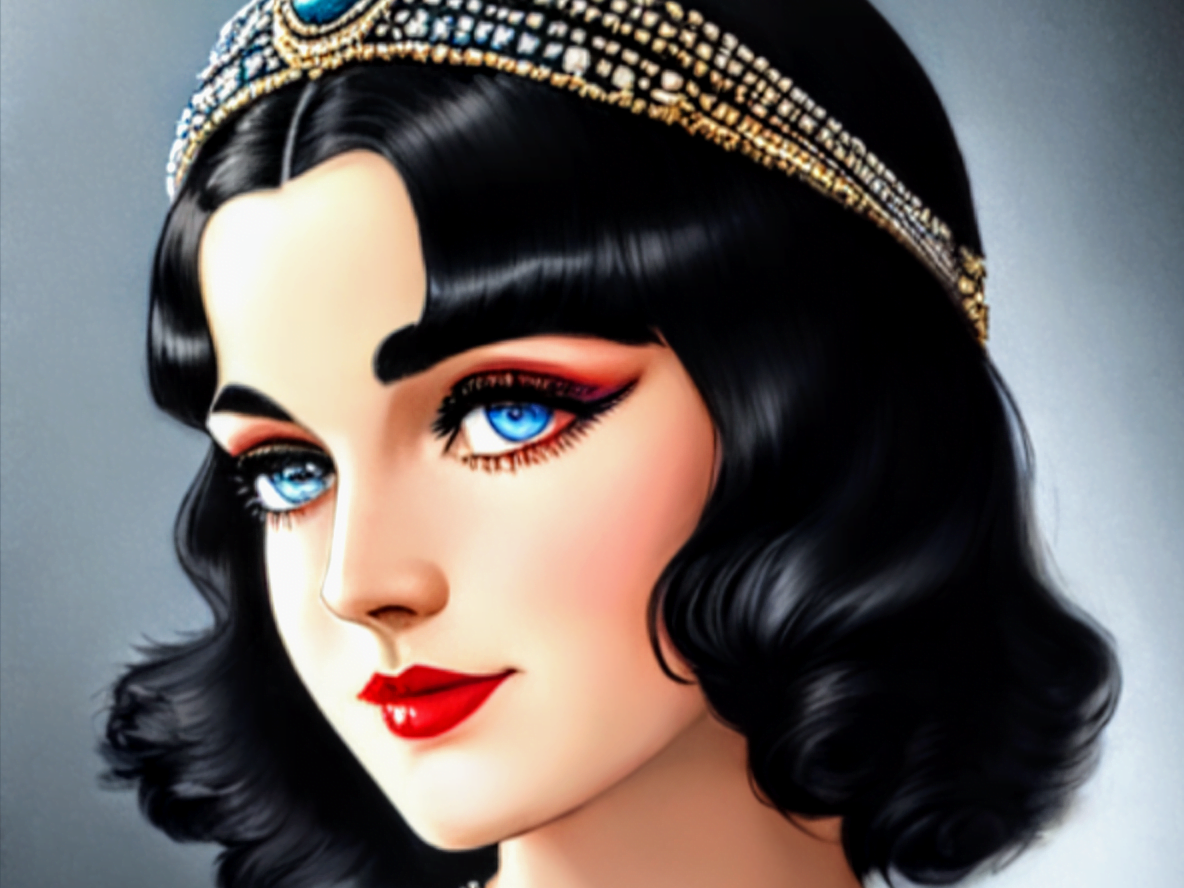Top Ten Best Eye Prompts for Stable Diffusion, Wombot, and WOMBO’s Dream app, as demonstrated by a 1920s flapper wearing a 1970s tube top and 1990s bellybutton ring
PROMPT:
1920s flapper wearing a 1970s tube top and 1990s bellybutton ring
Using artist styles used to be my go-to method for making my eyes shine in WOMBO’s Dream app and Wombot on Discord back when they were based on Stable Diffusion 1.4. Since WOMBO upgraded to SD 2, artist styles that once made my characters’ eyes beautiful now can turn them into children, or make them ugly, or turn them into ugly children.

Here are ten magic phrases I have learned to make eyes pop without using artist styles, demonstrated by a 1920s flapper wearing a 1970s tube top and a 1990s bellybutton ring.
#1: “Eyes”
PROMPT: eyes, 1920s flapper wearing a 1970s tube top and 1990s bellybutton ring
If you want to improve your character’s eyes, but only want to spend one token doing it, just putting “eyes” near the beginning of your prompt will help more than you’d think it would. It’s a little nudge to the AI that makes it think “Oh, yeah, people have eyes. Maybe I should give this person eyes instead of terrifying scratch pits.”

“Eyes” works best when it is at the start of the prompt. In fact, any of these suggestions will only be strong enough to fix your eyes if they are one of the first three or so details in your prompt. Don’t worry about separating them from the rest of your character – the AI can usually figure out where the eyes go once you have reminded it that they exist in the first place.
#2: “Beautiful eyes”
PROMPT: Beautiful eyes, 1920s flapper wearing a 1970s tube top and 1990s bellybutton ring
The classic. The first trick I found that worked, and the one I still use more than any other. “Beautiful eyes” also makes the rest of the face a little prettier as well. It’s like getting free lipstick with your mascara. (Caveat prompter: If you don’t want makeup on your characters, don’t make them beautiful.)
Other beauty words have a similar effect: “handsome” (works better for men) “extremely cute” (only works on kids or adults you want to be kids), “pretty,” “lovely,” “perfect,” and “pulchritudinous” all make eyes more beautiful.

#3: “Piercing eyes”
PROMPT: Piercing eyes, 1920s flapper wearing a 1970s tube top and 1990s bellybutton ring
When you want to make your character look at the camera, “piercing eyes” is your best friend. Three out of four times, your character will gaze intently through the screen at you. One potential side effect: since few brown eyes have ever been called “piercing,” adding this to your prompt often turns your eyes ice blue.
Words with similar effects (except for the ice blue thing): “dazzling,” “striking,” and “stunning.”

#4: “Rendered eyes”


These work better if your character looks cartoonish or computer generated. When used on realistic characters, it can give their whole body an slightly plastic look. “Rendered eyes by Pixar” works especially well, as long as you don’t mind if your characters look like Pixar made them
Similar words that can make your eyes look good and your character look computer-generated: “photorealistic,” “ultrarealistic,” etc.
You can offset the CG look by putting things like “CGI” and “plastic” in your negative prompts.
#5, 6, & 7: “Hidrocharme (or hidrocor) lenses, contacts, iris”
These can work well separately, and are very powerful together. All of them tell the AI, “Hey, you know that colored circle in the middle of the eye? How about you make it, y’know, a circle”
PROMPT: Beautiful eyes, iris, 1920s flapper wearing a 1970s tube top and 1990s bellybutton ring
“Iris” is polite about this. Similar to “eyes,” it is just a reminder to the AI that irises are a thing that exist. “Iris” and the rest of these all work much better if you specify some sort of “eyes” before them. I usually use “beautiful eyes.”

PROMPT: Beautiful eyes, contacts, 1920s flapper wearing a 1970s tube top and 1990s bellybutton ring
“Contacts” make the AI give your character contacts – clear round things that go on top of the iris, which needs to be round in order for the contacts to go on top of them. One potential side effect: “contacts” often pick up colors around them. If, for example, your scene has a lot of green neon, your character’s eyes might glow green. (Any clothes or hair you haven’t given a color might turn green as well.) You decide whether this is a bug or a feature.

“Hidrocharme / hidrocor lenses” is the most powerful of these prompts, and a reminder that Stable Diffusion knows a LOT of words. “Hidrocharme lenses” are irises with a dark line around them. “Hidrocor lenses” have no line.


“Hidrocharme lenses” make eyes look amazing in closeups and medium shots, but “hidrocor lenses” work better in wide shots where “hidrocharme lenses” can confuse the AI by making it try to add too much detail in too small a space.
Another term for a ring around the irises is “limbal rings,” which works just as well as “hidrocharme lenses.” There is also a condition called corneal arcus caused by fat deposits in the edge of the cornea that makes a blue ring around the irises (cornea, actually, but it looks the same.)
“Corneal arcus” made a blue ring and a black ring around the cornea when I tried it in a prompt using WOMBO’s Discord bot, but Wombot thought it looked so cool, it really wanted to make sure I saw the eyes. Or eye, in this case.

#8: NOT “Highly Detailed”
PROMPT: Highly detailed eyes, 1920s flapper wearing a 1970s tube top and 1990s bellybutton ring
“Highly detailed,” “ultra-detailed,” “hyper-detailed,” even “detailed” – these words need to stay far away from your eyes. When you think about it, eyes don’t actually have that many details – there is a little black circle in the middle, and a colored circle around that. “Highly detailed” doesn’t make the AI focus on these few details – it makes it add more details. It can add too many white reflection dots, extra limbal rings, or another layer of the sclera (the white part), which looks like daubs of whiteout in the eye. Mostly, the AI turns your eyes into scribbly messes.


The one, actually two, possible exceptions to this: “Detailed pupils” and “detailed iris.” These work because they tell the AI exactly where to add detail, but they only work in close-up shots where there is enough room in the eyes to add detail. Besides, eyes rarely need help to look good in closeups, so these are usually just a waste of tokens. In medium and wide shots, where the iris is just a small circle and the pupil is just a dot, trying to add detail to them brings us right back to scribbletown.

#9: “Poorly drawn eyes, cross-eyed, small eyes, bad eyes, messy eyes, ugly eyes, red eyes” (as negative prompts)
PROMPT: eyes, 1920s flapper wearing a 1970s tube top and 1990s bellybutton ring $poorly drawn eyes, cross-eyed, small eyes, red eyes$
Don’t forget to use your negative prompts! If you are spending too many tokens in your regular prompt, remember that negative prompts get their own set of 75 tokens. Putting any of these in your negative prompt will make your eyes look much better. You can even sometimes get hidrocharme lenses by putting “hidrocor lenses” in the negative prompts.

Don’t go too crazy, though – using all of these negative prompts at once is overkill, and might result in the AI turning your character around or cropping their head out of the picture so it doesn’t have to show the eyes at all.
Note: In Dream, your negative prompt goes between two dollar signs at the end of your prompt, and counts toward your maximum of 200 characters. Stable Diffusion and Wombot have their own sections for negative prompts.

#10: “Eyes a perfect mix of [celebrity1, celebrity2, celebrity3]”
PROMPT: Eyes a perfect mix of Persis Khambatta Dana Plato Margaux Hemingway, 1920s flapper wearing a 1970s tube top and 1990s bellybutton ring
If all else fails, invoking celebrities will almost always improve your characters’ eyes. (Possible exceptions: Steve Buscemi and Marty Feldman) But, as with artist styles, they will also strongly affect the rest of your character. Don’t be a deepfake dick! If you are going to use celebrities in any part of your character’s anatomy, use “a perfect mix of” at least three of them. Preferably ones who haven’t already been deepfaked to death.
The key to making this work: using stars who died young. If they lived into their 80s, there will be too many pictures of their crows’ feet to get good eyes. Morbid, but it works.
And speaking of death, in addition to the Rule of Three, I use the same rule for celebrities that I use for artist styles: I only use dead ones.
#11: Give up and fix it with inpainting or an external program like Photoshop or GFPGAN or Arc by Tencent.
No prompt, however perfect, is going to give you great eyes 100% of the time. Or even 10% of the time for wide shots. So just give up. And use a different program to fix them.
Inpainting/Edit with text
If you are using Stable Diffusion, you can use the power of inpainting https://stable-diffusion-art.com/inpainting_basics/ to fix bad eyes. In a nutshell, inpainting lets you select the parts of your image that suck (like the eyes) and then generate a new image that only goes in that spot. Since the AI only has to think about that one small area, it can do a much better job.
Dream and Wombot have a primitive version of inpainting called “Edit with text” that theoretically lets you do the same thing, but in practice goes hilariously wrong when you try to fix something as small as eyes.

GFPGAN or Arc by Tencent.

Above: Arc has a neat slider for before and after
Right: GFPGAN’s (great) first attempt. I ran the outputs through 3 times, but it wouldn’t let me do a 4th.

There are several programs designed specifically to clean up faces made by AI art generators, as well as old photos. GFPGAN and Arc by Tencent are two of the most popular. And for good reason, from my limited experience with them. If I had just taken my initial picture into either of them from the start, I wouldn’t have had to mess with any of these prompts. One word of caution with these: they are only designed to make realistic faces, which didn’t quite match my character.
Photoshop / GIMP
And of course, there’s always good old Photoshop. Or if you don’t want to give Adobe its vig every month, a free alternative like GIMP.
Wombot Update
As I prepared to post this, Wombot got ChatGPT functionality that supposedly can do inpainting, outpainting, and everything that ChatGPT 3 can do. I have only played with it for a few minutes, so I’m not sure if this particular error that I got immediately upon trying it out is par for the course, or just early jitters.

Wombot did manage to answer some questions about it’s capabilities.


Not so bad, Wombot.
What are your prompts for perfect eyes? Let me know in the comments. Please. My eyes still look like crap in full-body shots. If you know how to make them better, I will be your best friend forever… or at least until Stable Diffusion 3 comes out and hopefully fixes this mess.
Oh, and yes, I realize that none of them actually had a bellybutton ring. I’m a bit disappointed as well, but the point of “bellybutton ring” in the prompt was not to actually make one. It was to get the camera back far enough that fixing her eyes would be a challenge, but not so far as to be impossible. By mentioning her eyes and belly, we were guaranteed at least a waist-up shot. If I had mentioned something like a skirt (I thought about a 1960s miniskirt), the shot might have been too wide for any hope of saving her eyes.



Leave a Reply
You must be logged in to post a comment.